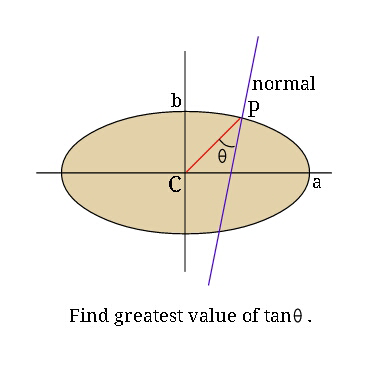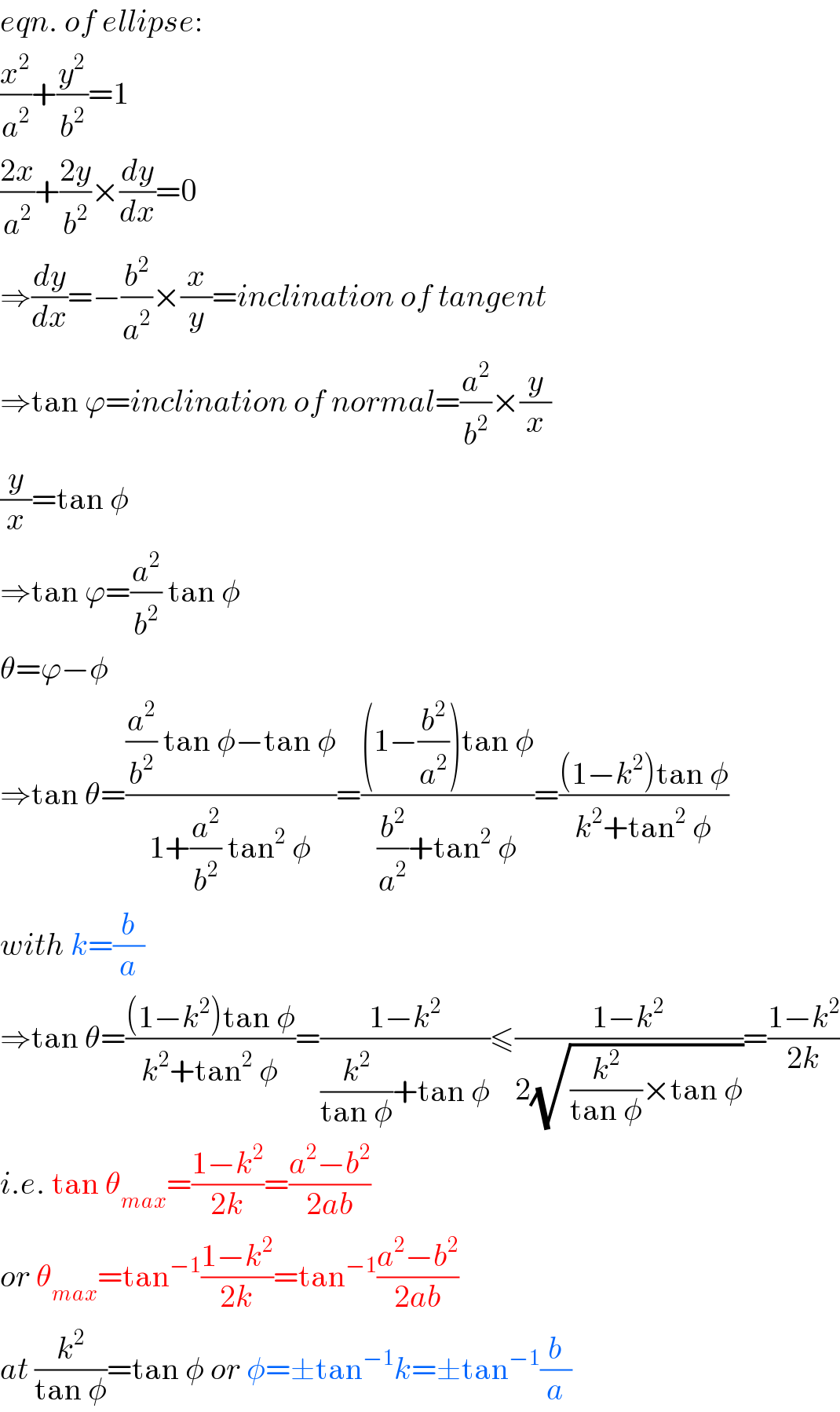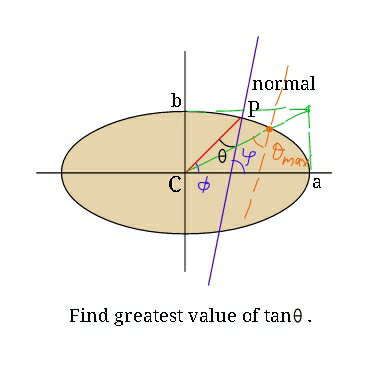Question Number 28464 by ajfour last updated on 26/Jan/18

Answered by mrW2 last updated on 26/Jan/18

$${eqn}.\:{of}\:{ellipse}: \\ $$$$\frac{{x}^{\mathrm{2}} }{{a}^{\mathrm{2}} }+\frac{{y}^{\mathrm{2}} }{{b}^{\mathrm{2}} }=\mathrm{1} \\ $$$$\frac{\mathrm{2}{x}}{{a}^{\mathrm{2}} }+\frac{\mathrm{2}{y}}{{b}^{\mathrm{2}} }×\frac{{dy}}{{dx}}=\mathrm{0} \\ $$$$\Rightarrow\frac{{dy}}{{dx}}=−\frac{{b}^{\mathrm{2}} }{{a}^{\mathrm{2}} }×\frac{{x}}{{y}}={inclination}\:{of}\:{tangent} \\ $$$$\Rightarrow\mathrm{tan}\:\varphi={inclination}\:{of}\:{normal}=\frac{{a}^{\mathrm{2}} }{{b}^{\mathrm{2}} }×\frac{{y}}{{x}} \\ $$$$\frac{{y}}{{x}}=\mathrm{tan}\:\phi \\ $$$$\Rightarrow\mathrm{tan}\:\varphi=\frac{{a}^{\mathrm{2}} }{{b}^{\mathrm{2}} }\:\mathrm{tan}\:\phi \\ $$$$\theta=\varphi−\phi \\ $$$$\Rightarrow\mathrm{tan}\:\theta=\frac{\frac{{a}^{\mathrm{2}} }{{b}^{\mathrm{2}} }\:\mathrm{tan}\:\phi−\mathrm{tan}\:\phi}{\mathrm{1}+\frac{{a}^{\mathrm{2}} }{{b}^{\mathrm{2}} }\:\mathrm{tan}^{\mathrm{2}} \:\phi}=\frac{\left(\mathrm{1}−\frac{{b}^{\mathrm{2}} }{{a}^{\mathrm{2}} }\right)\mathrm{tan}\:\phi}{\frac{{b}^{\mathrm{2}} }{{a}^{\mathrm{2}} }+\mathrm{tan}^{\mathrm{2}} \:\phi}=\frac{\left(\mathrm{1}−{k}^{\mathrm{2}} \right)\mathrm{tan}\:\phi}{{k}^{\mathrm{2}} +\mathrm{tan}^{\mathrm{2}} \:\phi} \\ $$$${with}\:{k}=\frac{{b}}{{a}} \\ $$$$\Rightarrow\mathrm{tan}\:\theta=\frac{\left(\mathrm{1}−{k}^{\mathrm{2}} \right)\mathrm{tan}\:\phi}{{k}^{\mathrm{2}} +\mathrm{tan}^{\mathrm{2}} \:\phi}=\frac{\mathrm{1}−{k}^{\mathrm{2}} }{\frac{{k}^{\mathrm{2}} }{\mathrm{tan}\:\phi}+\mathrm{tan}\:\phi}\leqslant\frac{\mathrm{1}−{k}^{\mathrm{2}} }{\mathrm{2}\sqrt{\frac{{k}^{\mathrm{2}} }{\mathrm{tan}\:\phi}×\mathrm{tan}\:\phi}}=\frac{\mathrm{1}−{k}^{\mathrm{2}} }{\mathrm{2}{k}} \\ $$$${i}.{e}.\:\mathrm{tan}\:\theta_{{max}} =\frac{\mathrm{1}−{k}^{\mathrm{2}} }{\mathrm{2}{k}}=\frac{{a}^{\mathrm{2}} −{b}^{\mathrm{2}} }{\mathrm{2}{ab}} \\ $$$${or}\:\theta_{{max}} =\mathrm{tan}^{−\mathrm{1}} \frac{\mathrm{1}−{k}^{\mathrm{2}} }{\mathrm{2}{k}}=\mathrm{tan}^{−\mathrm{1}} \frac{{a}^{\mathrm{2}} −{b}^{\mathrm{2}} }{\mathrm{2}{ab}} \\ $$$${at}\:\frac{{k}^{\mathrm{2}} }{\mathrm{tan}\:\phi}=\mathrm{tan}\:\phi\:{or}\:\phi=\pm\mathrm{tan}^{−\mathrm{1}} {k}=\pm\mathrm{tan}^{−\mathrm{1}} \frac{{b}}{{a}} \\ $$
Commented by ajfour last updated on 26/Jan/18

$${great},\:{suggests}\:{a}\:{shorter}\:{method} \\ $$$${hopefully}! \\ $$
Commented by ajfour last updated on 26/Jan/18

$${Thanks}\:{Sir}. \\ $$
Commented by mrW2 last updated on 26/Jan/18

